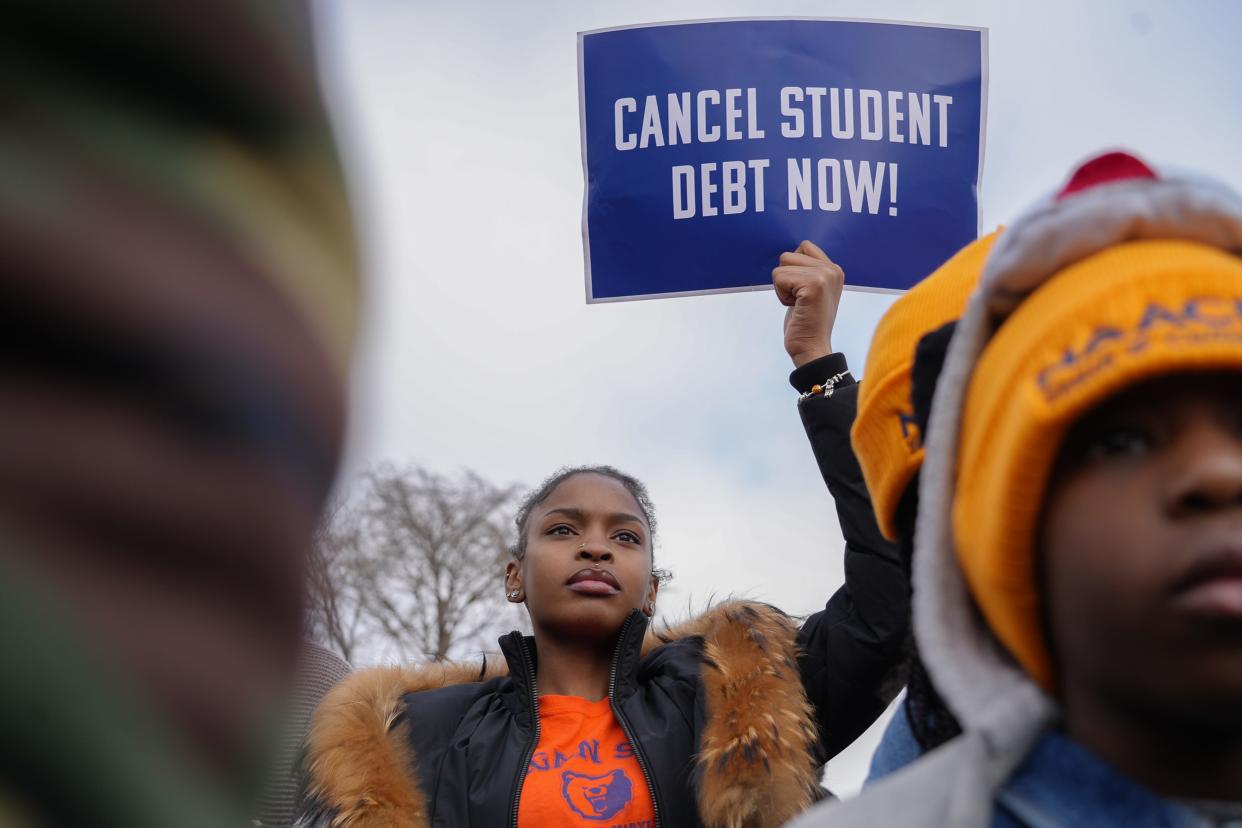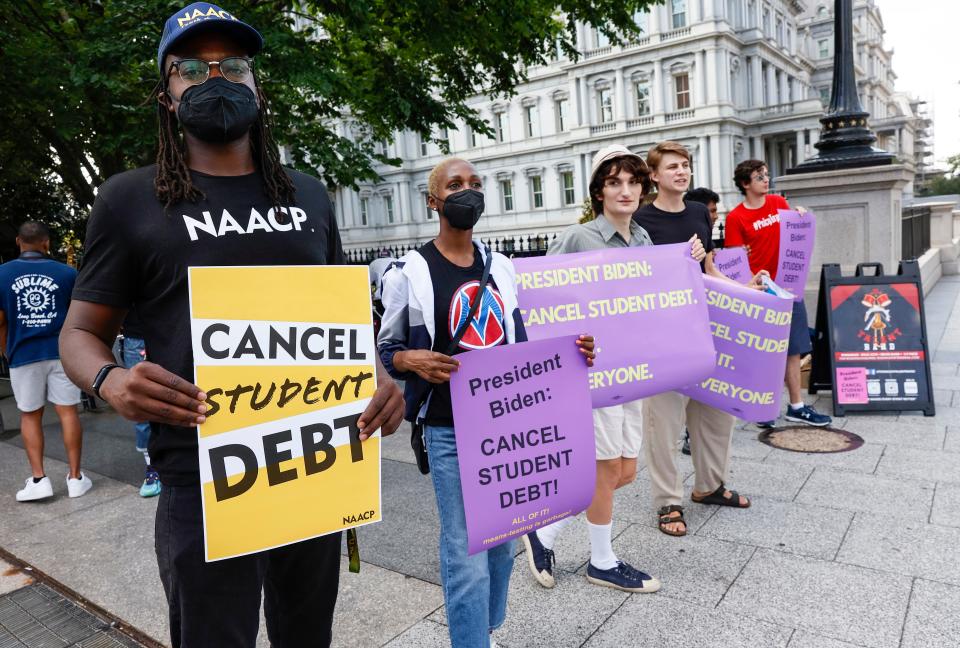Biden promised to make student loan forgiveness in bankruptcy court easier. But has he?

- Oops!Something went wrong.Please try again later.
Life led Elizabeth Hadzic and Kim Coles to bankruptcy court.
Hadzic, 50, a psychotherapist in Maryland, doesn’t make enough to support herself and her adult son, whose health struggles set her back thousands of dollars. Coles, an accountant in Oregon in her late 60s, was laid off last year.
Both have tens of thousands of dollars in student loan debt. Although they have been making payments on those loans for years, they no longer can. And both, in the absence of an alternative, have resorted to taking the costly, typically unsuccessful route of trying to get their loans discharged in bankruptcy court.
That’s where things diverge.
For Hadzic, bankruptcy is proving to be the answer to her financial woes. After months of litigation, she’s on track for a full discharge. In Coles’ case, the government is putting up a fight − though she is of retirement age − against discharging the balance of a loan she’s been paying down for more than a decade.
“I always paid my student loans,” Coles said in an interview. “I was never late.”
The disparity in how the government is treating their cases is indicative of the intractability of one of the country’s most extreme and inaccessible forms of student debt relief, as the Biden administration grapples with finding alternatives to the kind of sweeping student loan forgiveness option that the Supreme Court struck down in June.

Historically, only about 1 in 1,000 student-loan discharges have been successful in bankruptcy court. Last year, the Justice Department released new guidance for federal lawyers meant to streamline the process and, theoretically, lead to more discharges. In November of this year, the department said roughly 630 cases had been filed in 10 months using the new system, and that the “vast majority” of those borrowers received full or partial discharges.
“Because the new process is working well, the Justice Department is not making any changes to the guidance at this time,” said Vanita Gupta, an associate attorney general in a statement last month.
While many acknowledge the system has indeed improved, the process hasn’t been a total overhaul, according to a USA TODAY review of recent discharge cases, as well as interviews and emails with more than a dozen borrowers, lawyers and student loan experts. Whether a bankrupt borrower can actually have their student loans discharged still depends on which federal lawyer is assigned to the case and in which jurisdiction their case is filed. The timeline varies, too.
Despite the changes, some say it’s too early for the administration to be claiming success.
“I do think that it’s better than it was before,” said Dalié Jiménez, a law professor at the University of California, Irvine, and the director of the Student Loan Law Initiative. “But that was a very low bar.”
Bankruptcy rarely erases student loans. Even when it does, the US government has put up a fight
Ending ‘absurd rules’
Escaping student debt is never simple. From working multiple jobs to living with their parents, millions of Americans go to great lengths to try to manage the crushing economic burden that a modern college degree imposes.
For many reasons, the road to relief through bankruptcy court is one less traveled. The success rate for such cases has been abysmal. The process can be long. And critics argue the legal standard borrowers must meet to qualify for a discharge is exceedingly high.
Even President Joe Biden is one of those critics, despite supporting a 2005 law that made the process tougher when he was a senator. His views evolved over time, and by his 2020 presidential campaign, he promised to "end the absurd rules that make it nearly impossible to discharge student loan debt in bankruptcy."
Daniel Zibel, vice president of National Student Legal Defense Network, said despite the more streamlined process, outcomes can still differ depending on where a case is litigated.
“It’s not like there’s one central office where this all gets done,” he said.
Much of the irregularity, some advocates say, can be traced to an aggressiveness with which some assistant U.S. attorneys have historically fought such cases. Before the 2022 guidance, discharge cases were completely adversarial, according to Ed Boltz, a North Carolina-based bankruptcy attorney. When bankruptcy judges ruled in favor of borrowers, assistant U.S. attorneys often saw it as a failure, he said.
“The knee-jerk reaction of a lot of assistant U.S. attorneys is to just fight as hard as possible,” said Persis Yu, the deputy executive director of the Student Borrower Protection Center. “At the end of the day, it is in some places the same people.”
Now, they’re being compelled to shift their thinking about just how collectible student loan debt really is.
“That’s an adjustment that some are adapting to much more quickly than others are,” Boltz said.
The Justice Department, while lauding the progress it has made over the past year, acknowledged the frustrations in a statement to USA TODAY.
“We nevertheless appreciate that cases are not always moving as expeditiously as we would like, and we understand – including from conversations with attorneys and practitioners whose clients are going through the process – that this can be difficult for borrowers during an already uncertain time,” spokesperson Terrence Clark said.
Clark said the agency, along with the Education Department, remains committed to improving the ability to address student loans via bankruptcy.
A ‘pretty brutal’ process
Coles, the accountant, doesn’t know what she’s going to do.
In March, she set out to have her student loan, which she took out in 2009, discharged in bankruptcy court. Court documents from July valued it at more than $26,000 with interest, though the original loan was about $38,000, she said.
“The only reason she hasn’t retired is because she has these student loans hanging over her head,” said her lawyer, Rex Daines.
But the federal government denied her request in July, arguing in court filings that she didn’t make a good enough case for a full discharge. According to court documents, on Dec. 13 the assistant U.S. attorney assigned to her case offered to recommend a partial discharge.
If Coles agrees to those terms, she’ll still have to pay roughly $500 a month for the next three years. That’s an expense she says she simply can’t afford, at least not without considering selling her house and moving into a smaller apartment to free up cash. (She previously filed for Chapter 13 bankruptcy and did not have to sell her home, unlike in other forms of bankruptcy.)
“I don’t know who the policymaker was on that, saying, ‘Make this person keep working until she’s 70,’” Daines said. “It’s pretty brutal.”
Daines said his firm has filed almost two dozen student loan discharge cases in Oregon since the new Justice Department guidance came out a year ago. A few resulted in full relief; a few others were denied and dismissed.
For some, much-needed relief
For Elizabeth Hadzic, the Maryland psychotherapist, however, the guidance may soon help wipe out her student loan debt.
She graduated with a master’s degree in psychology in 2012, but her earnings haven’t risen substantially since then. A mother of three, she also took out three loans to pay for her kids’ schooling. Though she made payments consistently, the debt across five loans eventually swelled to more than $120,000.
“I had this idea that I’m going to borrow this money, but it’ll be OK because I’m going to make so much more money as a therapist,” she said. “I do make more money as a therapist, but it doesn’t matter.”
She was approved for bankruptcy this year. Her lawyer, Timothy Chambers, said she’s now on track for a full loan discharge, too.
“For somebody like her, it really alleviates the financial stress that she had been living in,” Chambers said.
According to a Justice Department memo sent to federal lawyers in November 2022, the new process was “intended to streamline the handling of student loan discharge cases for both Department attorneys and debtors, ensure greater transparency for everyone involved in these cases, and lead to fairer, more consistent results, in which the government agrees to recommend discharge in situations where the facts support it.”
“What the guidance set out to do is working, and it’s working quite well,” Chambers said. “That doesn’t mean there’s not more the government can do. There’s always going to be more.”
A lot more, some would say.
“So far there has been no improvement in how these cases are handled despite what (the) Biden administration is claiming,” California bankruptcy attorney William Winfeld wrote in an email. “It seems to me it is business as usual.”
Future of broader student loan forgiveness uncertain
The ongoing challenges also bring new urgency to Biden’s latest attempt at student debt relief.
This fall, the Education Department held a series of talks with a panel of borrowers, lawyers and advocates to brainstorm its next steps. Over the course of those negotiations, it became clear that the Biden administration, still scarred by this summer’s Supreme Court ruling, doesn’t seem eager to take its chances with another attempt at far-reaching relief.
Student loan relief talks end without a final answer on who should get help
Bankruptcy was one of many topics that came up in those talks, which concluded somewhat bitterly. As the department mulls the possibility of another meeting to take more recommendations, borrowers can expect a full proposal by May at the earliest.
“The line-drawing, it sucks,” said Boltz, the bankruptcy lawyer. “So much of this debt is uncollectible.”
Contributing: Chris Quintana, USA TODAY
Zachary Schermele is a breaking news and education reporter for USA TODAY. You can reach him by email at zschermele@usatoday.com. Follow him on X at @ZachSchermele.
This article originally appeared on USA TODAY: Does student loan forgiveness lie in bankruptcy court? For some, maybe

